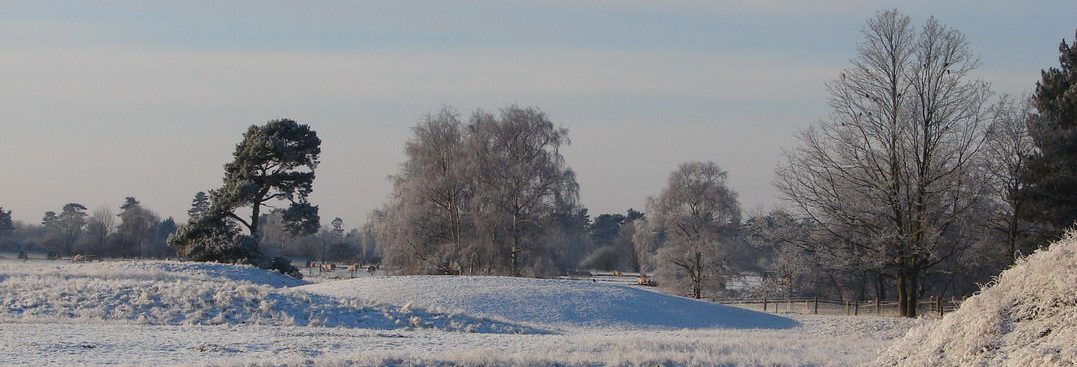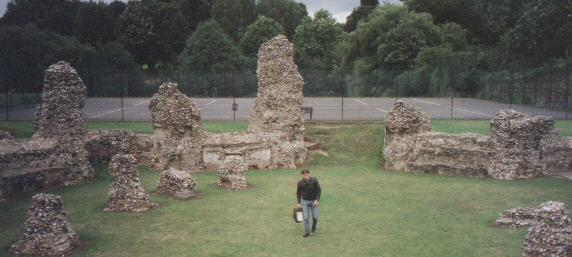The remains of the once great Abbey of St Edmund at Bury, ruined following the Dissolution of the Monasteries in 1539, provide a striking contrast to the glories of Ely, which escaped destruction because it had become an episcopal cathedral in 1109. Today at Bury, bare, partly built-over ruins – mostly rubble cores from once great walls and supporting pillars – are all that is left of what was one of the richest Abbeys in England. Originally founded circa 633 by the first East Anglian martyr-king, Sigeberht (Liber Eliensis, I, 1), it later became the burial-place and shrine of the last East Anglian martyr-king, Edmund, one of the patron saints of England.
The rubble cores of the crypt-pillars are all that is left of the Shrine of St Edmund, which would have stood roughly above my head [thanks to Jane Newick for the photograph].
Despite a huge quantity of later legendary material, the near-contemporary entries in the A manuscript of The Anglo-Saxon Chronicle, written in Winchester in the early 890’s, imply that King Edmund was probably killed in battle at or near Thetford by the Danish micel here, ‘Great Army’, led by the Ragnarrson brothers, Ivarr, Ubbe, and Halfdan, in the winter of 869. The date of his festival commemorating the day of his death, 20th November, is therefore credible.
It was in Edmund’s honour that the Abbey later flourished under successive English monarchs as the cult of St Edmund became one of the most powerful in Mediaeval England. On behalf of St Edmund the Abbots ruled vast estates, including the Eight and a Half Hundreds of Thingoe, another ancient territory, which survived as the administrative unit of West Suffolk until 1974.
Visitors today can still follow the footsteps of countless medieval pilgrims towards the focal eastern end of the Abbey, at the heart of which was St Edmund’s Shrine. Here the probably mummified body of one the last of the Wuffings lay exerting his curiously enduring posthumous power for so long. Close by were the adjacent Shrines of St Botolf of Iken, who died June17th 680, and of St Jurmin, the Wuffing prince killed with his father Anna at the Battle of Bulcamp in 654.
© Copyright Dr Sam Newton, Blotmonaþ AD 2000
Further Reading
Gransden, Antonia, “The legends and traditions concerning the origins of the Abbey of Bury St Edmunds” English Historical Review, 100 (1985), pp.1-14.
Scarfe, Norman, “St Edmund’s Corpse: Defeat into Victory” in his Suffolk in the Middle Ages (Boydell 1986), pp.55-71; an earlier version of this essay appears as “The Body of St Edmund: An Essay in Necrobiography”, Proceedings of the Suffolk Institute of Archaeology and History, 31 (1970), pp.303-317.
Whitelock, Dorothy, “Fact and Fiction in the Legend of St Edmund”, Proceedings of the Suffolk Institute of Archaeology and History, 31 (1970), pp.217-233.
For more pictures of the Abbey ruins see Simon’s Suffolk Churches’ page
http://www.suffolkchurches.plus.com/buryabbey.html
For 3D Virtual Reality Fly-Throughs of the the inside and outside of the reconstructed Abbey, visit the BBC History Multimedia zone at http://www0.bbc.co.uk/history/multimedia_zone/3ds/


